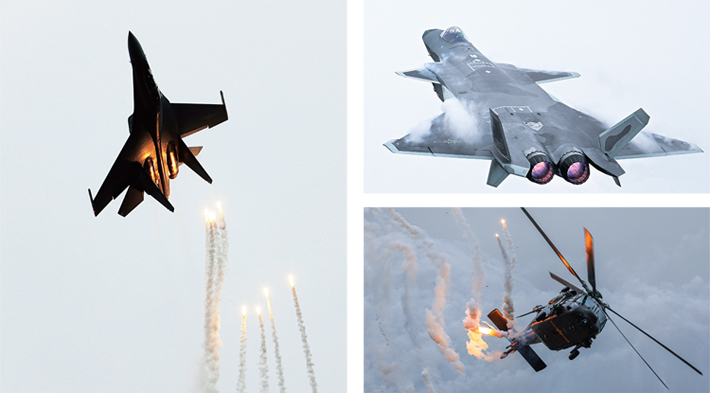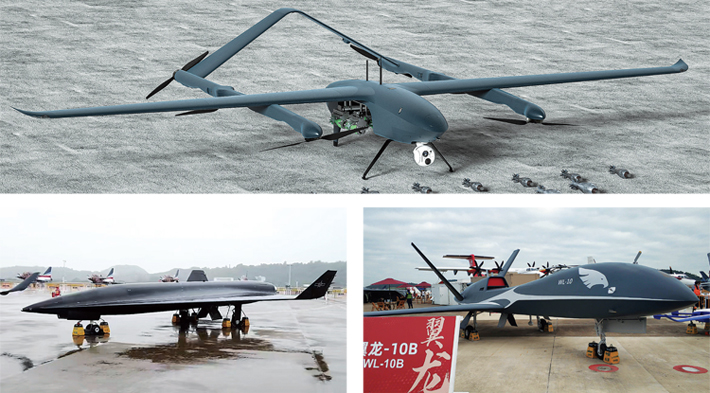INDIAN ARMED FORCES CHIEFS ON OUR RELENTLESS AND FOCUSED PUBLISHING EFFORTS

The insightful articles, inspiring narrations and analytical perspectives presented by the Editorial Team, establish an alluring connect with the reader. My compliments and best wishes to SP Guide Publications.

"Over the past 60 years, the growth of SP Guide Publications has mirrored the rising stature of Indian Navy. Its well-researched and informative magazines on Defence and Aerospace sector have served to shape an educated opinion of our military personnel, policy makers and the public alike. I wish SP's Publication team continued success, fair winds and following seas in all future endeavour!"

Since, its inception in 1964, SP Guide Publications has consistently demonstrated commitment to high-quality journalism in the aerospace and defence sectors, earning a well-deserved reputation as Asia's largest media house in this domain. I wish SP Guide Publications continued success in its pursuit of excellence.
- A leap in Indian aviation: Prime Minister Modi inaugurates Safran's Global MRO Hub in Hyderabad, Calls It a Milestone
- All about HAMMER Smart Precision Guided Weapon in India — “BEL-Safran Collaboration”
- India, Germany deepen defence ties as High Defence Committee charts ambitious plan
- True strategic autonomy will come only when our code is as indigenous as our hardware: Rajnath Singh
- EXCLUSIVE: Manish Kumar Jha speaks with Air Marshal Ashutosh Dixit, Chief of Integrated Defence Staff (CISC) at Headquarters, Integrated Defence Staff (IDS)
- Experts Speak: G20 Summit: A Sign of Global Fracture
China’s Display of Military Might
Since its inception in 1996, Airshow China has become an important window for showcasing advanced military, aviation and aerospace technologies developed by China

The Airshow China 2022, the 14th China International Aviation and Aerospace Exhibition, was held in Zhuhai in China’s Guangdong Province. More than 740 domestic and overseas enterprises from 43 countries and regions participated in the exhibition on-site or online to display new technologies and new products in aerospace and national defence. A total of over 100 aircraft participated in the event parked outdoors, and the indoor exhibition area covered over 10 thousand square meters. The PLA Air Force (PLAAF) static exhibition area increased by 10 per cent compared with the previous edition of the show. Even the flight performance and ground equipment demonstration were more true-to-life experience compared with previous ones.
At this air show, weapons and equipment such as J-20 stealth fighter jets, Y-20 heavy transport aircraft, KJ-500 airborne early warning (AEW) aircraft, H-6K bombers, HQ-9B air-defence missile system, Z-20 medium-lift utility helicopters, YU-20 tanker aircraft, J-16 fighter jets, and Attack-2 unmanned aerial vehicles (UAVs) were unveiled, and the Bayi Aerobatics Team of the PLAAF and the Red Eagle Aerobatic Team of the PLAAF Aviation University also performed aerobatic stunts in Zhuhai. They are among the 50 types of weapons the People’s Liberation Army Air Force had send to this year’s air show to highlight equipment put into service since 2000. The J-20 was on display on the ground for the first time, along with other “20 series” aircraft such as the Y-20 heavy lifter and Z-20 helicopter. There was a bewildering array of weapons, vehicles, helicopters and aircraft as Chinese industry seeks to meet the needs of the rapidly modernising People’s Liberation Army and to capture lucrative export markets. China also unveiled a life-size replica of China’s orbiting Tiangong space station, and Commercial Aircraft Corporation of China, Ltd (COMAC) received new orders for 300 C919 passenger aircraft.
FIGHTERS AND MISSILES
At the show, a YY-20 aerial tanker, the J-16 fighter and a Wing Loong 2 UAV all made their flying debut. Also on display was the very important Z-20 helicopter, a Chinese facsimile of the American Black Hawk. The airshow also featured other aircraft and weapons including the H-6K bomber and HQ-9B surface-to-air missiles. After six days of intensive flying display performances, the J-20 fighter jets showcased its strengths that reflect the stealth aircraft’s strong and increasing combat capabilities. It is expected that the J-20 will enhance its manoeuvrability with new engines with thrust vectoring control. Taihang series turbofan engines with 2D and 3D thrust vectoring control nozzles were also on display at the Airshow China 2022. Another highlight of the J-20s’ display at this year’s air show was their landings and take-offs, in front of the general public for the first time, confirming that the runway distance required for the J-20 to take off and land is very short. This is of tactical significance because in combat, using only a small portion of runway to take off and land can greatly increase the warplane’s operational capability.

China also revealed several of its latest air defence missile and laser systems at the Airshow. The HQ-9B surface-to-air missile weapon system of the Chinese People’s Liberation Army (PLA) Air Force on display at the Airshow China featured for the first time a new type of missile in addition to the previously known one. Eight of this new type of missile can be carried by the same transporter erector launcher that can carry four of the previously known type, as the new missile is about the same length but obviously thinner than the old one. The larger missiles will be used to intercept targets farther away, and if remaining targets come closer, the smaller missiles can be used.
Another new air defence system, the HQ-11 universal terminal defence system, made its debut at the airshow. It consists of a vehicle equipped with eight missile vertical launch cells and another vehicle equipped with a close-in gun. Both vehicles are equipped with corresponding radar systems. The HQ-11 is designed to cover a shorter range than the HQ-9B, but it is very fast and mobile so that it can accompany valuable assets on the move. It can intercept air-to-surface missiles, guided bombs, cruise missiles and other aerial weapons like fixed-wing aircraft and helicopters.
China also for the first time unveiled its fourth-generation advanced air defence equipment, the HQ-16FE mid- to long-range air defence missile weapon system. Developed by the Eighth Academy of the state-owned China Aerospace Science and Technology Corp, the system’s transporter erector launcher can carry six missiles at a time. The HQ-16FE can intercept multiple types of targets including manned aircraft, drones, cruise missiles and tactical ballistic missiles in a very intelligent and aggressive manner. Compared with its predecessors, the HQ-16FE has a longer range and a stronger anti-deception capability.
Together with the air defence missiles, a type of vehicle-mounted tactical laser weapon of the PLA Air Force also made its debut at the airshow. It is a new type of combat force that targets low, slow, small targets like drones. It can either operate alone or form a network of multiple vehicles, or become a part of a larger air defence weapon system.
China is building a world-class comprehensive air defence system that can safeguard the country’s sky from potential attacks. The air defence systems displayed by the PLA Air Force at the Airshow China 2022 showed that China’s air defence weapons no longer rely on imports.
UNMANNED SYSTESM
China showed a wide range of unmanned aerial vehicles (UAV), ground vehicles and unmanned sea vessels that can work independently or with other manned systems. China is famous for its vast array of UAVs, the two most famous families being the Wing Loong and CH/Rainbow families of armed UAVs.
China unveiled its latest military drone model – Wing Loong-3, the first to reach intercontinental range while equipped for aerial self-defence. The WL-3 also features a stronger strike capability with as many as 16 missiles and bombs. Other new drones in the Wing Loong family – including the Wing Loong-1E and Wing Loong-10A – also made their debut. The China Aerospace Science and Technology Corp (CASC) displayed an improved CH-7 stealth UAV with a 26m wingspan and maximum take-off weight of 10 tonnes. Another mysterious stealthy UAV was the Cloud Shadow CS-5000T with blended wing design. Another newcomer was a near-space hypersonic technology testbed called the MD-22.

(Clockwise from Top) LOONG 5 Small Military Bombing Drone; Wing Loong-10B; WZ-8 Combat Drone.
Air show China also offered a rare glimpse into its latest unmanned maritime vehicles. China State Shipbuilding Corporation (CSSC) displayed a variety of unmanned underwater vehicles (UUVs) at the air show, in numbers far exceeding those unveiled at previous editions of the biennial event. These included the Haishen 6000 (Poseidon 6000), a 7.6 metre-long UUV with a displacement of 3 tonnes, a maximum working depth of 6,000 metres (19,700 feet) and able to reach speeds of up to 4 knots. Multiple sensors on board can help it detect mines, and it can also carry towed acoustic decoys that use sonar signals to deflect active torpedoes.
Also showcased for the first time was the CSSC’s recently released EA63, a remotely operated vehicle built to be stationed on surface ships for mine-sweeping action, able to detect and neutralise marine mines both at depth and on the seabed. Two unmanned coastal defence vessels, the L30 Watcher and M75 Protector, were also displayed, both produced by Yunzhou, a Zhuhai-based technology company.
China’s most advanced anti-drone defence systems were one of the features of the air show. The systems are designed to detect and intercept swarms of unmanned aerial vehicles (UAVs) at low altitudes and combine air-defensive, artificial intelligence and anti-missile technology. State-owned China Aerospace Science and Industry Corporation (CASIC), said its system, the ZR-1500, integrated early-warning detection, command and control, as well as interception missiles. The system combined portable missiles from the PLA’s active HQ-17AE short-range missile defences, sophisticated radars, and its multiple purpose unmanned vehicle to form a “cost-saving, tight, dragnet defensive network to detect and intercept incoming aircraft and drones”.
CONCLUSION
This year’s airshow displayed a wide spread of China’s achievements in aerospace and defence technologies over the past decade. According to official sources, the 14th Airshow China 2022, concluded on November 13 in Zhuhai, China saw the signing of business deals worth $39.8 billion. As China continues its march towards total self-reliance in science and technologies for military use, the world will look forward to the 15th China International Aviation & Aerospace Exhibition which will be held in Zhuhai from November 12 to 17, 2024.





